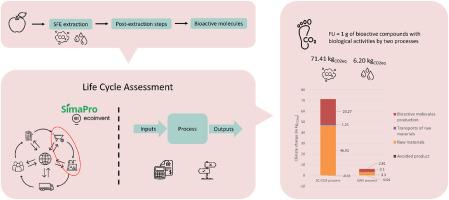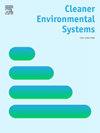亚临界还是超临界?从苹果渣中提取生物活性化合物的生命周期比较评价
IF 4.9
Q2 ENGINEERING, ENVIRONMENTAL
引用次数: 0
摘要
苹果渣(AP)是苹果汁和苹果酒行业的副产品,是一个重大的废物挑战,2021年全球产量约为500万吨。AP通常在垃圾填埋场处理,造成健康和环境风险。尽管它的处置,AP仍然是一个有价值的生物活性化合物的来源,公认的生物特性。本研究评估了使用创新技术提取这些生物活性化合物的碳足迹,即超临界二氧化碳(SC-CO2)和亚临界水萃取(SWE)。利用SimaPro软件和ecoinvent数据库,对从AP中提取1 g生物活性化合物进行了生命周期评估(LCA; cradle-to-gate)。结果表明,SC-CO2工艺的排放量为71.42 kgCO2eq,而SWE工艺的排放量显著低于6.20 kgCO2eq。这些结果突出了不同提取技术对环境的影响,并强调了更可持续的做法在确定AP价值方面的潜力。本研究强调了对可持续技术进行生命周期评估(lca)的重要性,为未来的工业实践和政策决策提供了重要的见解。此外,研究结果表明,标记为“绿色”的技术并不一定具有环境优势,这促使人们重新考虑当前的可持续性定义。本文章由计算机程序翻译,如有差异,请以英文原文为准。

Subcritical or supercritical? A comparative life cycle assessment of bioactive compound extraction from apple pomace
Apple pomace (AP), a by-product of the apple juice and cider industries, represents a significant waste challenge, generating approximately 5 million tons produced worldwide in 2021. Often disposed of in landfills, AP contributes to health and environmental risks. Despite its disposal, AP remains a valuable source of bioactive compounds, recognized for their biological properties. This study assesses the carbon footprint associated with extracting these bioactive compounds using innovative technologies, namely supercritical CO2 (SC–CO2) and subcritical water extraction (SWE). Utilizing SimaPro software and the ecoinvent database, the Life Cycle Assessments (LCA; cradle-to-gate) were conducted for extracting 1 g of bioactive compounds from AP. The findings reveal that the SC-CO2 process emits 71.42 kgCO2eq, while the SWE results in significantly lower emissions of 6.20 kgCO2eq. These results highlight the environmental impact of different extraction technologies and emphasize the potential for more sustainable practices in valorizing AP. This study highlights the importance of conducting Life Cycle Assessments (LCAs) for sustainable technologies, offering critical insights that can inform future industrial practices and policy decisions. Furthermore, the findings indicate that a technology labeled as 'green' is not necessarily environmentally superior, prompting a reconsideration of current sustainability definitions.
求助全文
通过发布文献求助,成功后即可免费获取论文全文。
去求助
来源期刊

Cleaner Environmental Systems
Environmental Science-Environmental Science (miscellaneous)
CiteScore
7.80
自引率
0.00%
发文量
32
审稿时长
52 days
 求助内容:
求助内容: 应助结果提醒方式:
应助结果提醒方式:


